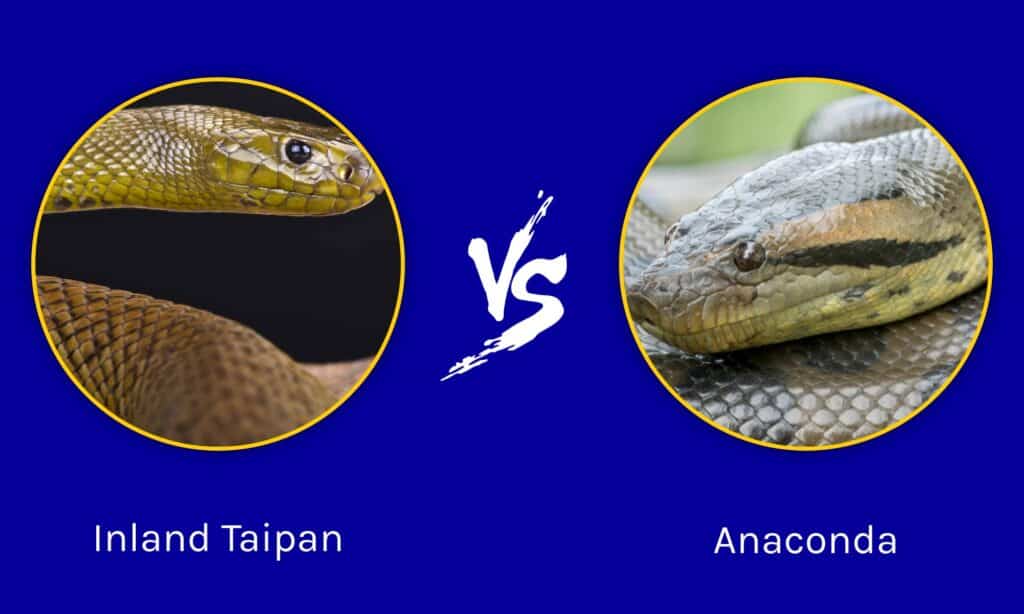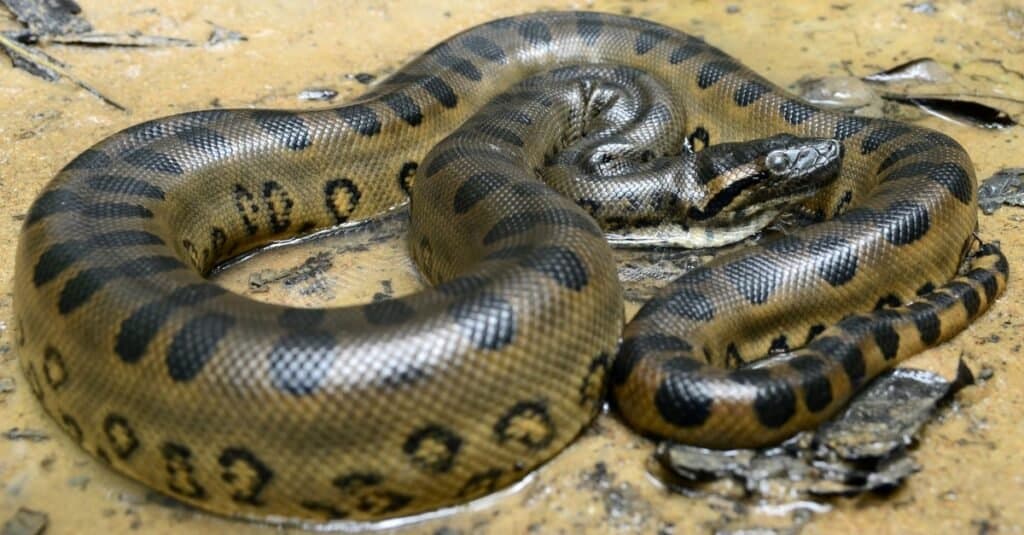The world is filled with very dangerous snakes. Whether they are massive constrictors or use deadly venom to kill their foes, these reptiles are highly adept killers. What happens when you pit the snake with the most powerful venom against the largest snake in the world? Today, we’re showcasing an inland taipan vs anaconda fight to show you which of these creatures is the deadliest of the two! We’ll show you which of these deadly snakes would win and how it would go down in the wild!
Comparing an Inland Taipan and an Anaconda

| Inland Taipan | Anaconda | |
|---|---|---|
| Size | Weight: 3lbs-4.4lbs Length: 4ft-6ft, up to 9ft maximum | Weight: 250lbs -550lbs Length: 17-22 feet Diameter: 12 inches |
| Speed | – 5 mph | -5 mph on land -10 mph in the water |
| Offensive Capabilities | – Considered the deadliest venom in the world – 44mg average venom load with 110mg maximum – Capable of killing between 100 and 280 humans with a single bite – Nearly 100% envenomation rate and delivers several bites – Bites quickly and several times | – Powerful bite for grasping – Immensely powerful constriction that kills by damaging the prey’s circulatory system while causing internal damage – Fantastic hunting senses |
| Defenses | – Prefers to flee from potential predators when possible | – Their eyes on their head allow them to skim the surface of the water. – Swims in water – Large size – Camouflage |
| Predatory Behavior | – Ambush predator | – Ambush prey in and out of water – Bites and holds prey while coiling around them and constricting. |
What Are Key Differences Between an Inland Taipan and an Anaconda?

Anacondas are very large, powerful constrictors.
©Mark_Kostich/Shutterstock.com
The greatest differences between an inland taipan and an anaconda are their size and methods of attacking. The inland taipan is about 9ft long at maximum, weighs 4.4lbs, and uses powerful venom to kill its prey, while the anaconda can grow over 22ft long, weighs 550lbs, and constricts its prey to death.
The unique qualities of these snakes will greatly impact their success in fighting one another. However, we have to look at many other factors to determine which creature is more likely to win a battle.
What Are the Key Factors in a Fight Between an Inland Taipan and an Anaconda?

An inland taipan vs anaconda fight will be a contest of speed, size, and their ability to kill foes with haste.
©reptiles4all/Shutterstock.com
The most impactful factors of any fight in the animal kingdom include the size, speed, and offensive capabilities of the two combatants. These are three major elements that we have to explore and compare. Yet, we must also examine the animals’ defenses and how they prey on others.
Once we explore all these factors, we will gain a more complete view of the creatures. Using that information, we’ll be able to determine which animal is going to win with greater certainty.
Inland Taipan vs Anaconda: Size
Anacondas are larger than inland taipans by quite a great margin. The average anaconda can grow between 17ft and 22ft, weighing up to 550lbs, and having a diameter of 12 inches.
However, the inland taipan is a much smaller snake. This snake grows to be about 4.4lbs and 6ft long, but snakes up to 9ft long have been witnessed.
Anacondas have a massive size advantage.
Inland Taipan vs Anaconda: Speed
The inland taipan and anaconda have equal speeds on land. They can both move at about 5 mph. However, the anaconda can move up to 10 mph over short distances in water.
Anacondas and inland taipans are tied for speed.
Inland Taipan vs Anaconda: Offensive Capabilities
The inland taipan and anaconda are both incredibly deadly snakes when it comes to their offensive powers. The inland taipan has the deadliest venom of any land snake. Their venom is so strong that it can kill up to 289 people in a single bite. Furthermore, they always deliver venom in their bites; they do not give dry bites.
Not only do they bite and deliver venom, but they bite quickly and rarely settle for a single bite. They will bite as often as possible.
The anaconda uses its massive size to overwhelm its foes. They bite their prey, wrap their body around it, and constrict until the animal’s circulatory system gives out. They are natural ambush predators that wait for just the right moment to bite.
Both creatures are the best at their type of offense.
Inland Taipan vs Anaconda: Physical Defenses
The inland taipan’s best defense is its willingness to flee from its enemies. Although that often saves the animal from getting into trouble, its true defense is its offense. If the animal decides to turn and bite, it can kill most predators in its range.
The anaconda is loaded for bear when it comes to defense. The snake’s skin acts as camouflage within its environment and the body of an anaconda is massive. The anaconda is simply too large for most animals to attempt to kill!
The anaconda has a defensive advantage.
Inland Taipan vs Anaconda: Predatory Behavior
The inland taipan and the anaconda are ambush predators. The anaconda will often wait with most of its body hidden below the water for something to get close enough. Then, it will lash out, snatch the animal, and drag it into the water while wrapping around it.
The inland taipan will often wait in crevices and near water for its prey to appear. They will get close to their future meal and then bite it several times to ensure death.
Both animals are very effective predators.
Who Would Win in a Fight Between an Inland Taipan and an Anaconda?

Anacondas are simply too large and heavy for most animals to overcome.
©Patrick K. Campbell/Shutterstock.com
An anaconda would win a fight against an inland taipan. The size difference, in this case, would result in the anaconda being able to bite, constrict, drown, or use all three methods to kill the much smaller snake. The most likely outcome is that the anaconda would grab the inland taipan by the head or body and then crush it before swallowing it whole.
Although the inland taipan has very powerful venom, it does not work instantly. Even if the venomous snake bit the anaconda, it would still need to buy a lot of time for the venom to take hold.
Meanwhile, the anaconda will still have the opportunity to fight back, and it would probably kill the inland taipan before it died itself. Thus, even if the inland taipan strikes first the anaconda would still probably kill its foe before succumbing. For all these reasons, the anaconda is going to win this fight.
Anaconda Vs. Gorilla: Who Would Win?

Gorillas are one of the few animals strong enough to take on an Anaconda.
©iStock.com/SooniosPro
For most animals that they could face in combat, the massive size and constricting grip of the anaconda would be too much to overcome. Gorillas, however, possess an impressive amount of strength and far superior intelligence when compared to their reptilian opponent. They are also considerably larger than most anacondas and possess a variety of combat skills that a creature without arms or legs cannot contend with consistently. Ultimately the battle would likely ensue with the anaconda making a futile attempt at striking and constricting the ape before the gorilla fought back, and using its pummeling fists and gnashing teeth would put an end to the anaconda assailant by crushing its skull. Unless the snake were particularly lucky or was up against a previously injured or sick ape, a gorilla would beat an anaconda every time.
The photo featured at the top of this post is © Ken Griffiths/Shutterstock.com
Discover the "Monster" Snake 5X Bigger than an Anaconda
Every day A-Z Animals sends out some of the most incredible facts in the world from our free newsletter. Want to discover the 10 most beautiful snakes in the world, a "snake island" where you're never more than 3 feet from danger, or a "monster" snake 5X larger than an anaconda? Then sign up right now and you'll start receiving our daily newsletter absolutely free.
Thank you for reading! Have some feedback for us? Contact the AZ Animals editorial team.






